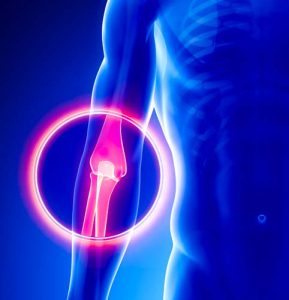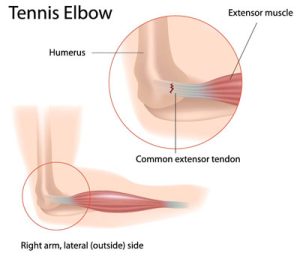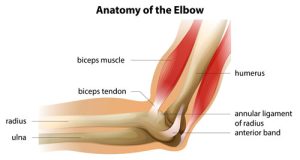
Sample 1
Treatment of Elbow Pain: Lateral and Medial Epicondylitis
Patients are often annoyed by the limitations elbow pain imposes on their daily activities as much as the pain itself. Tennis/golfer’s elbow or lateral/medial epicondylitis are common tendinopathies you will encounter at some point in practice, if not frequently. As a practitioner addressing pain, you will want to differentiate lateral and medial epicondylitis from…

More in Course Materials…
Sample 2
Biomedicial Mechanisms
Epicondylitis is a pain condition primarily involving the wrist extensors and flexors. The pronators and supinators may also be affected. The condition results from overuse or chronic, repetitive use of these muscles causing the tendons to become strained. Over time, microtrauma occurs where the tendon attaches to the bone. However, acute injury can also occur if the tendon is exposed to an excessive load. Epicondylitis technically means inflammation of the epicondyle, but the condition is not caused by inflammation of a bony prominence. Instead, the condition involves trauma to the joint’s tendons. What we call epicondylitis is really a tendinosis or a tendinopathy of the elbow tendons caused by trauma. Lateral epicondylitis is commonly referred to as tennis elbow, while medial epicondylitis is commonly referred to as golfer’s elbow.
To review the anatomy and physiology of the elbow, recall these features of the structure:
Elbow bone structure and articulation
• The elbow joint is a synovial joint.
• The elbow is a monaxial, hinge joint that moves in an angular motion in one direction. It allows for flexion and extension of the forearm.
• The elbow joint is formed by three bones: head of the radius bone, the trochlea notch of the ulna bone, and the trochlea of the humerus bone.
• The ulna has a prominence called the olecranon, which has an olecranon bursa covering it. When we hit the prominent olecranon against something, it hurts because we actually hyperstimulate a nerve. We commonly say …
More in Course Materials…

Sample 3
Diagnosis and Treatment
Mechanisms
From the TCM standpoint, both lateral and medial epicondylitis may arise from invasion of pathogenic factors, injury, or overuse of the joint. The joint can easily be invaded by wind, cold and/or damp pathogens leading to bi (painful obstruction) syndrome. Trauma can lead to both qi and blood stagnation resulting in limited movement as well as pain. Chronic overuse can lead to Qi, Blood, and Yin Deficiency resulting in an empty channel condition.
Diagnosis and Patterns
The patterns include, but are not limited to, the following:
Acupuncture Treatment with Point Analysis
With elbow pain, there are many approaches you can take. You may decide to treat the pain ipsilaterally (same side) or contralaterally (opposite side). You may treat according to reverse body image such as treating the knee region for elbow pain. You may use Connecting Point strategies or treat according to basic local body points. As stated above, three patterns can arise, including trauma, pathogen invasion, or overuse leading to deficiency of Qi, Blood, and Yin. Based on the presentation, you should select the plan most appropriate for the patient.
Connecting Points — Connecting (Luo) points can be used to treat empty and full channel conditions. This approach is useful for patients presenting with chronic patterns of Qi, Blood, and Yin deficiency with Empty Channels. The Connecting Point pathways are described in the classic text, the Spiritual Axis. You may use Connecting Points in two ways:
When using this principle based on full or empty symptoms of the Connecting channel, the Connecting Points are selected on the opposite side and on the interiorly-exteriorly related channel. For example, in a case such as elbow pain due to emptiness in the Large Intestine (LI) Channel, needle the opposite side Connecting (Luo) point for the LI interiorly-exteriorly related channel. So, for left lateral (LI channel-related) elbow pain, needle some local Large Intestine points on the left, such as LI 11 or LI 12, with LU 7 (Luo point) on the right side.
Basic Points — For elbow pain, you can also needle according local and ashi points using some basic points. The basic points include points located on the three Yang channels of arm as well as GB 34. These basic Yang channel arm points are also located on the medial and lateral side of the arm, so they can be used for both medial and lateral epicondylitis. GB 34 is the Influential point for treating any condition affecting the sinews:
More in Course Materials…